Small Pink Flowering Trees (With Pictures): Identification Guide

Small pink flowering trees are a stunning addition to any small yard or compact space. Their vibrant pink blooms create a captivating spectacle during the flowering season.
Some of the best small pink flowering to increase the appeal of your garden include the eastern redbud, black lily magnolia, or cherry blossom trees. These small trees will add a pop of color to your garden without taking up too much space. Some of the small pink flowering trees are not only visually attractive but also low maintenance, making them a great addition for compact gardens or small yards.
This article is an identification guide for small pink flowering trees. In this article you will find descriptions, images, and essential gardening information about the best small pink flowering trees for your garden.
Small Pink Flowering Trees (With Pictures)
Here are some of the best small pink flowering trees:
Eastern Redbud (Cercis canadensis)
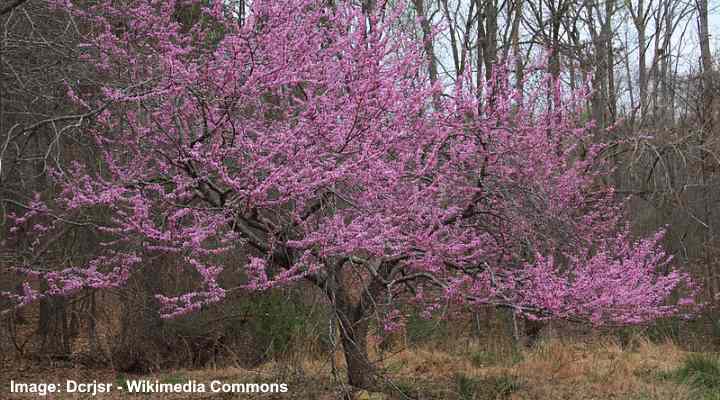
The eastern redbud is a small deciduous tree known for its stunning clusters of tiny rosy-pink flowers. In the summer, the tree showcases bright green, heart-shaped leaves with a hint of red. The leaves turn a stunning shade of yellow in the fall, enhancing the autumn landscape. The height of this tree ranges from 20 to 30 ft. (6 to 9 m), while its width can extend up to 35 ft. (10 m).
Eastern redbuds are popular trees due to their striking magenta-pink flowers that cover their leafless branches.
Some identifying features of the eastern redbud are its heart-shaped, broadly ovate leaves, rose-colored spring flowers, and reddish-purple winter buds.
Eastern redbuds flourish in USDA zones 4 – 9. These decorative trees prefer growing in areas with full sun to partial shade and require well-draining soil that remains consistently moist.
Related reading: How to identify varieties of redbud trees.
Mature Size: 20 – 30 ft. (6 – 9 m)
USDA Hardiness Zones: 4 – 9
Sun: Full sun to part shade
Cherry blossom trees (Prunus)
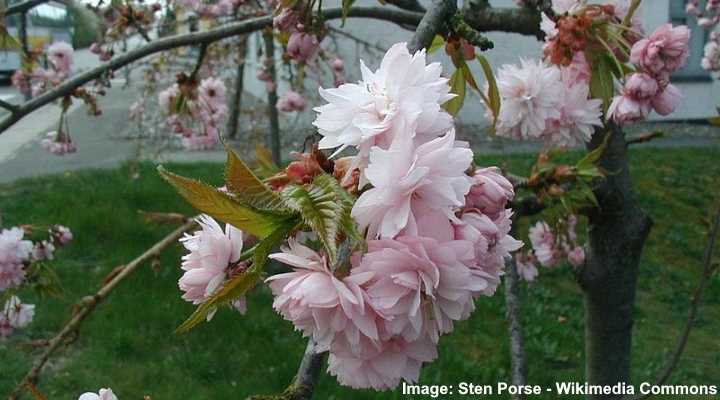
Japanese weeping cherry ‘Kiku-Shidare-Zakura’ has stunning ruffled pink flowers
Cherry blossom trees stand out as some of the most attractive small trees, renowned for their delicate light pink flowers. These deciduous trees bloom in spring, showcasing single flowers with five petals or double flowers with up to 300 petals. Dwarf ornamental cherry trees reach a height and width of 6.5 to 13 ft. (2 – 4 m).
Deciduous cherry blossom trees can be identified by their spreading branches and vase-shaped, rounded canopy. During mid- to late spring, the pink flowers appear in hanging clusters.
Flowering dwarf weeping cherry trees are a good option for small yards or compact landscapes. Standing at heights ranging from 6.5 to 13 ft. (2 – 4 m), these trees feature arching branches that form a beautiful spectacle of cascading pink hues, evoking the image of a blooming waterfall.
Cherry blossom trees grow best in USDA zones 4 – 9 and require full sun and moist, well-drained soil.
Related reading: How to identify the many types of flowering cherry trees.
Mature Size: 6.5 – 13 ft. (2 – 4 m)
USDA Hardiness Zones: 4 – 9
Sun: Full sun
Saucer Magnolia (Magnolia x soulangeana)
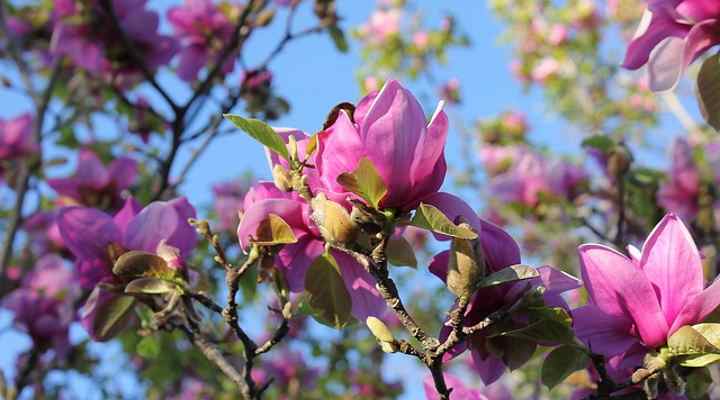
The saucer magnolia is a large, spreading shrub or small tree with striking purple-pink, goblet-shaped tulip flowers. The magnolia flowers, appearing on bare branches in spring, create a dramatic floral display. The tree also has dark green, oval-shaped leaves.
In mid-spring, the saucer magnolia’s large, leathery, dark green leaves form a canopy of dense shade. The saucer magnolia has an attractive rounded crown before the leaves fall in autumn. However, these trees may also be evergreen in warmer climates.
Saucer magnolias grow best in USDA zones 6 – 9. For best results, plant in moist, slightly-acidic well-drained soil and full sun.
Mature Size: 20 – 25 ft. (6 – 7.6 m)
USDA Hardiness Zones: 6 – 9
Sun: Full sun
Purple Leaf Plum Tree (Prunus cerasifera)
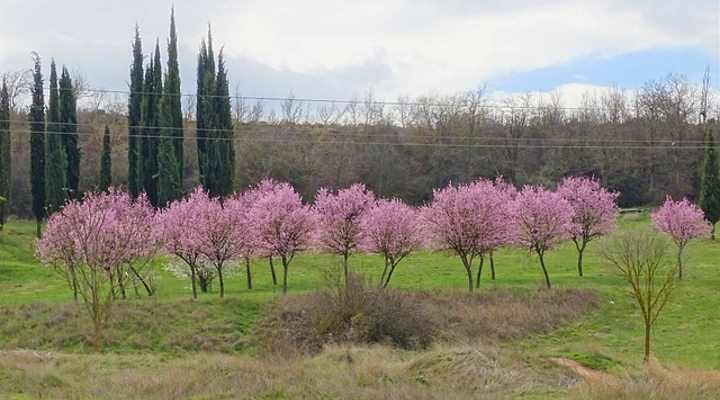
Purple Leaf Plum
The purple leaf plum is a deciduous shrub or small tree known for its ornamental, sweet-smelling pink flowers and dark burgundy or purple leaves. The stunning flowers of this tree feature five petals with each measuring 1 inch (2.5 cm) across.
The purple leaf plum tree reaches a height of between 15 and 25 ft. (4.5 – 8 m). The tree has a vase-shaped crown and dense, lush foliage.
The purple leaf plum, also known as the cherry plum tree, is an ornamental tree that thrives in moderately fertile, well-drained soil with adequate moisture. This tree thrives in full sunlight, though it can withstand partial shade. Keep in mind that an excess of shade results in the leaves turning green.
The purple leaf plum tree also produces round, plum-like yellow or red edible fruit.
Mature Size: 15 – 25 ft. (4.5 – 8 m)
USDA Hardiness Zones: 4 – 8
Sun: Full sun
Burgundy Desert Willow (Chilopsis linearis ‘Burgundy’)
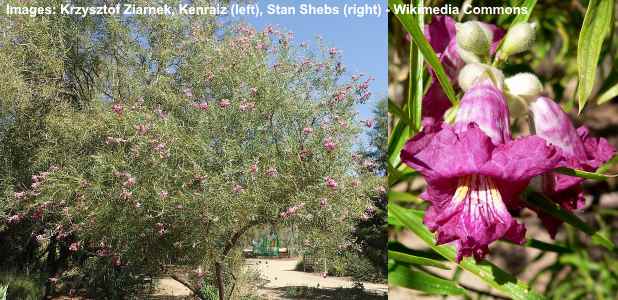
The small burgundy desert willow tree can be identified by its large, trumpet-shaped flowers, which range in hues from magenta-pink to purple. From late spring and early summer, these vibrant flowers cover the tree, creating a stunning explosion of color. The tree’s nectar-rich blossoms serve as a magnet for hummingbirds and butterflies, further enhancing its charm.
The burgundy desert willow showcases long, narrow, willow-like leaves. Its airy green foliage beautifully contrasts with the purplish-pink flowers. This pink-flowering tree’s adaptability makes it suitable for planting in xeriscape gardens, desert gardens, or wildlife gardens. The tree can be used as either an accent piece or play a role in erosion control.
The burgundy desert willow’s unique colors and ability to tolerate drought and heat makes it a standout choice for landscapes in arid regions. In addition, this plant has strong resistance against the majority of pests and diseases, making it an excellent low-maintenance option for your garden.
Mature Size: 15 to 20 ft. (4.5 – 6 m) tall and wide
USDA Hardiness Zones: 7 to 9
Sun: Full sun
Common Smoke tree (Cotinus coggygria)
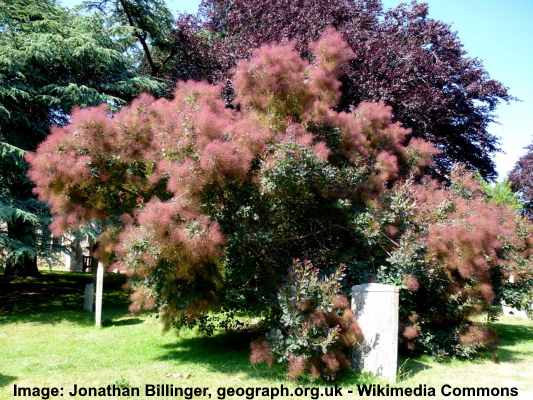
The common smoke tree is a stunning deciduous tree frequently cultivated as an ornamental plant. It displays attractive clusters of reddish-pink flowers. These distinct flowers feature delicate threads that give them a soft, smoky appearance. During autumn, the tree’s foliage undergoes a transformation, shifting hues from purple to shades of red, yellow, or orange.
Certain varieties of smoke trees are well-adapted to colder climates. These flowering trees thrive in abundant sunlight, which enhances the vibrancy of their foliage, but they can also grow in partial shade.
Smoke trees can be planted to serve various purposes in your landscape, such as flowering hedges, screens, or eye-catching specimen trees, enriching your outdoor space with decorative visual appeal.
Despite its relatively short lifespan of approximately 20 years, most gardeners would agree that the smoke tree’s ornamental beauty makes the tree well worth it.
Mature Size: 10 to 15 ft. (3 – 4.5 m) tall and wide
USDA Hardiness Zones: 4 to 8
Sun: Full sun or partial shade
Western Redbud (Cercis occidentalis)
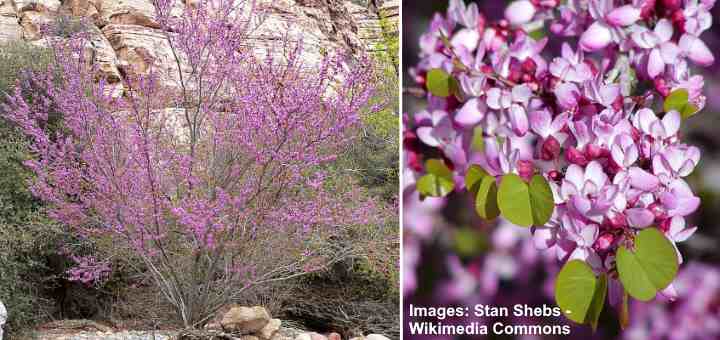
The California-native western redbud is a deciduous shrub or small tree known for its beautiful pink flowers and open, rounded canopy shape. It also has round, heart-shaped leaves that are bright green in color. In early spring, the tree’s flowers bloom, transforming the canopy into a spectacular display of pink flowers. As autumn approaches, the leaves transform into brilliant hues of golden yellow or rusty red.
Throughout the year, western redbud trees enhance the beauty of residential gardens and landscapes. After the blooming period, purple bean-like seed pods appear. In winter, the tree’s beauty is enhanced by its compact and irregular branching pattern. Western redbuds are excellent specimen trees for gardens with limited space, thanks to their small size and multi-trunked growth habit.
Western redbud trees are drought-tolerant once established. They thrive in various soil types but prefer well-drained soils. These trees are relatively low-maintenance, making them a practical choice for those looking to improve the appearance of their garden landscape.
Mature Size: 10 to 15 ft. (3 – 4.5 m) tall and wide
USDA Hardiness Zones: 6 to 9
Sun: Full sun to partial shade
Black Lily Magnolia (Magnolia liliiflora ‘Nigra’)
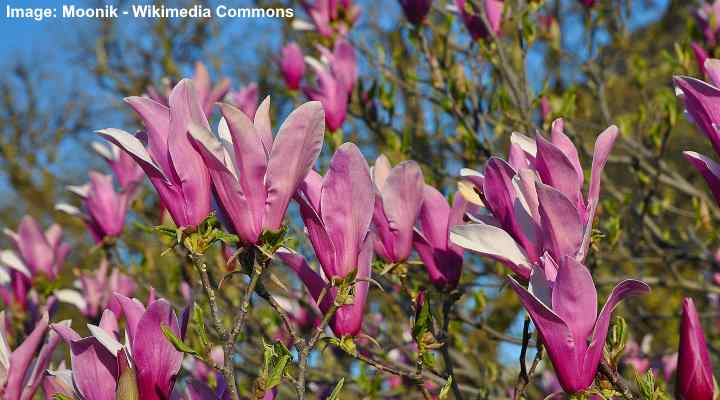
The charming black lily magnolia is a dwarf tree renowned for its beautiful lily-shaped blossoms, which come in a range of hues from deep pink to purple. The tree starts blooming in late spring and makes sporadic appearances throughout the summer. The vibrant flowers beautifully contrast against the backdrop of glossy, dark green leaves.
Black lily magnolia’s small size makes them a good choice for compact spaces or small yards. Whether planted as an accent plant, specimen plant, or used as a focal point in a lawn, these small flowering trees are sure to add beauty to their surroundings. To ensure optimal growth and blooming, plant them in well-drained, slightly acidic soils.
Mature Size: 8 to 12 ft. (2.4 – 3.6 m) tall and wide
USDA Hardiness Zones: 5 to 9
Sun: Full sun to partial sun
Pink Peacock Flower (Caesalpinia pulcherrima ‘Rosea’)

The charming pink peacock flower is a small ornamental tree or shrub covered with clusters of attractive pinkish-red flowers. These bowl-shaped flowers have long, slender stamens emerging from their center, giving it a distinctive appearance. Equally impressive is the tree’s foliage with fern-like leaves that beautifully contrast with its brown seed pods.
The pink peacock flower is a great option for smaller gardens as a beautiful accent tree due to its compact size. Its spine-covered branches make it a good security solution when used as a hedge, privacy screen, or foundation plant.
With its vibrant pink-red flowers, the tree becomes a highly desirable choice for bringing a burst of color and visual appeal to any garden landscape.
Mature Size: 10 to 15 ft. (3 – 4.5 m) tall and 6 to 12 ft. (1.8 – 3.6 m) wide
USDA Hardiness Zones: 9 to 11
Sun: Full sun
Chinese Plum Tree (Prunus glandulosa)
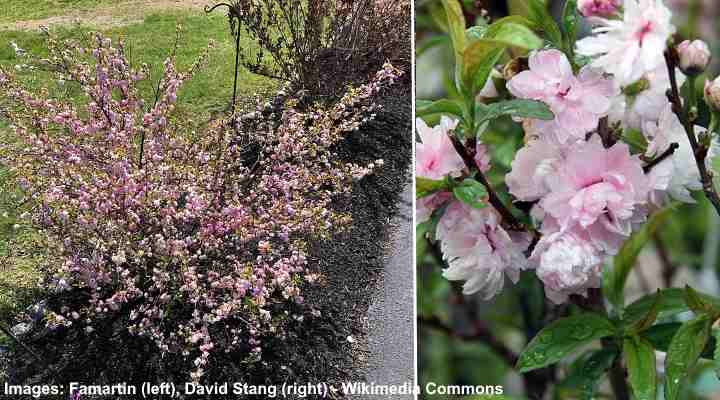
The Chinese plum tree, also known as the flowering almond, is a charming shrubby tree famous for its pretty pink blossoms. This deciduous tree forms attractive clusters of pinkish-white flowers, creating a colorful spectacle. In early spring, before the leaves appear, the tree is adorned with a beautiful display of pink blooms, resembling cherries. With the arrival of autumn, the oval green leaves of the tree transition into a yellow color.
Growing Chinese plum trees requires minimal effort because they readily adapt to diverse soil types, as long as they are well-drained. The dwarf flowering Chinese plum tree is a favored option for ornamental purposes, providing front or backyards with a touch of beauty.
Mature Size: 4 to 5 ft. (1.2 – 1.5 m) tall and wide
USDA Hardiness Zones: 4 to 8
Sun: Full sun to partial shade
‘Prairifire’ Crabapple (Malus prairifire)
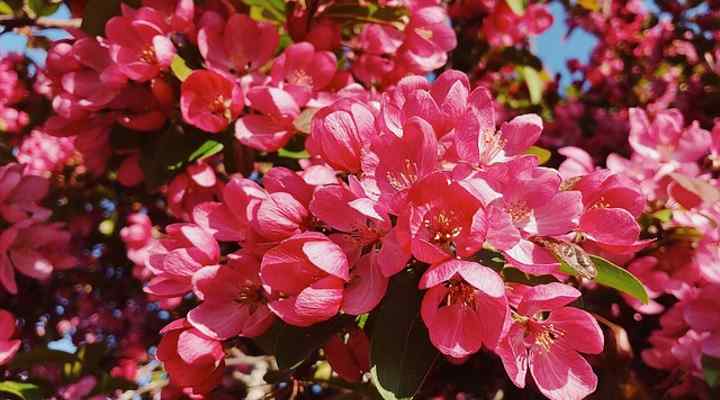
The ‘Prairifire’ crabapple stands out as a charming, fruit-bearing tree, celebrated for its stunning dark pink to red blossoms. During mid to late spring, these flowers bloom in dense clusters, covering the upright, rounded canopy. The striking dark pink colors of the tree enhance the visual appearance of any landscape. Following the flowering period, the tree produces colorful, purple-red fruits that bear a resemblance to cherries.
‘Prairifire’ crabapple trees has dark green, pointy leaves with purplish-red veins. In autumn, the leaves turn into a beautiful golden-bronze color. The tree’s glossy, dark red bark with unique lenticels enhances its overall appearance.
The decorative charm of ‘Prairifire’ crabapple trees makes them a popular choice for cultivation in small gardens. For optimal growth, plant these trees in soil that is moderately fertile and well-draining. With their attractive flowers and fruit that draw in pollinators, birds, and other wildlife, these trees are an excellent fit for wildlife gardens.
Mature Size: 15 to 20 ft. (4.5 – 6 m) tall and wide
USDA Hardiness Zones: 4 to 8
Sun: Full sun
Susan Magnolia (Magnolia Susan)
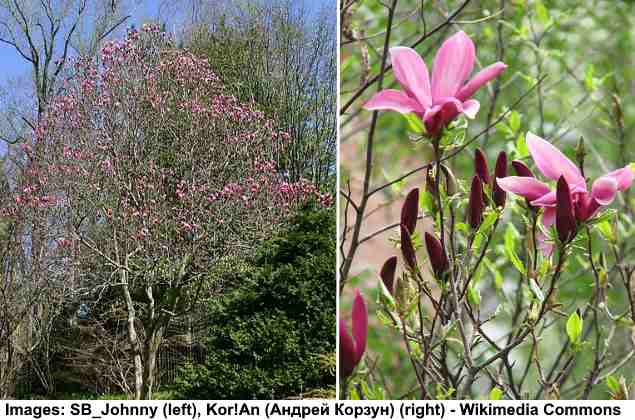
The Susan magnolia is a dwarf tree recognized for its stunning, tulip-like purple-pinkish flowers that bloom in spring. These fragrant blossoms flower sporadically throughout the summer months. Each flower is cup-shaped with six twisted petals that are 5 inches (13 cm) in length. The outer part of the petals features a deep purple-pink shade, creating a striking contrast with the lighter hue on the inner side.
The Susan magnolia tree forms a striking contrast to its vibrant flowers with its dark green, ovate leaves. In autumn, the leaves transition into a yellow hue before dropping. Due to its compact size, the Susan magnolia is an ideal choice for small gardens, city gardens, or as a a focal point in any landscape.
The Susan magnolia tree is low-maintenance and can adapt to various soil types, although it thrives best in well-drained, organically rich soil. For optimal growth, it is recommended to provide the tree shelter from cold winds.
Mature Size: 8 to 12 ft. (2.4 – 3.6 m) tall and wide
USDA Hardiness Zones: 3 to 8
Sun: Full sun to partial shade
Related articles:
- The Most Beautiful Small Flowering Trees
- The Best Small Ornamental Trees
- Stunning Pink Flowering Trees
- Beautiful Spring Blooming Pink Flowering Trees
